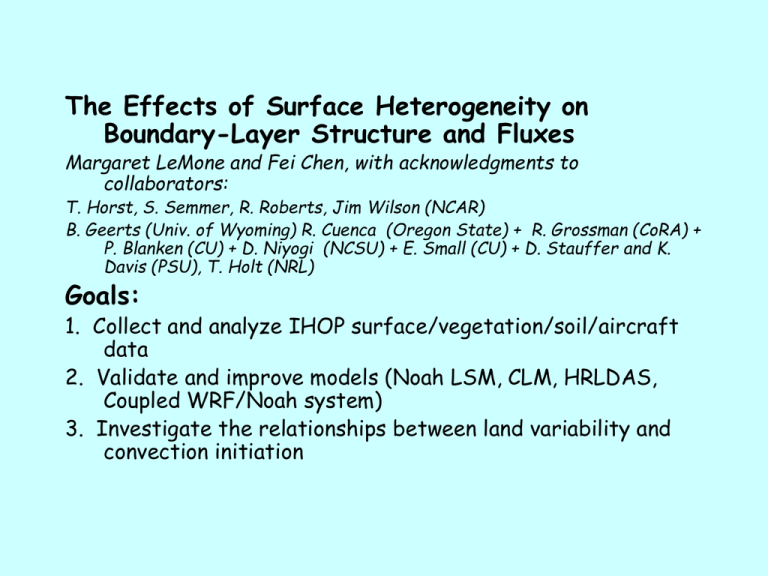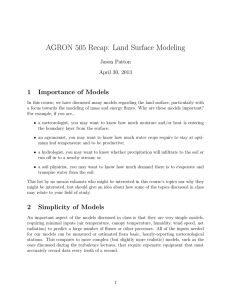The Effects of Surface Heterogeneity on Boundary-Layer Structure and Fluxes collaborators:
advertisement

The Effects of Surface Heterogeneity on Boundary-Layer Structure and Fluxes Margaret LeMone and Fei Chen, with acknowledgments to collaborators: T. Horst, S. Semmer, R. Roberts, Jim Wilson (NCAR) B. Geerts (Univ. of Wyoming) R. Cuenca (Oregon State) + R. Grossman (CoRA) + P. Blanken (CU) + D. Niyogi (NCSU) + E. Small (CU) + D. Stauffer and K. Davis (PSU), T. Holt (NRL) Goals: 1. Collect and analyze IHOP surface/vegetation/soil/aircraft data 2. Validate and improve models (Noah LSM, CLM, HRLDAS, Coupled WRF/Noah system) 3. Investigate the relationships between land variability and convection initiation 15 King-Air BLH Missions + 10 NCAR Surface, Soil, and Vegetation Stations Central Track Sites 4, 5, 6 Eastern Track Sites 7, 8, 9 ABLE Network Western Track Sites 1, 2, 3 CU station 10 OK Mesonet Characteristics of the Flight Tracks The Eastern Track Compare CASES-97 To IHOP David Gochis (left) and Bob Grossman (right) Eastern Track: Radiometric Surface Temperature IHOP: Riparian areas warm CASES97: Riparian areas cool Winter wheat effect? Eastern Track: Potential Temperature IHOP: West warm CASES97: Center warm CASES-97: Mesoscale Circulations Flight Track Evaluation of flux measurements for relating to surface heterogeneity 1. Statistics F 2l F F Lx 1 2 1 rw2's ' 2 rw's ' Lx = record length F = flux (average w’s’) lF = turbulence integral scale rw’s’’2 = correlation between w’ and s’ 2. Adherence to surface energy balance constraint: H + LE = Rn – G ~ constant spatially H = sensible heat flux LE = latent heat flux Rn = net radiatioin G = heat flux into ground 3. Existence of horizontal variability June 17, 20, 22 composite (21 legs) Last rain on 15 June 17 J 201 deg at 7.7 m/s 20 J 163 deg at 5.3 m/s 22 J 179 deg at 9.4 m/s For comparison…CASES-97 Sensible Heat Flux (H) -96.9o is site of low H; maximum shifted to east CASES-97 LE (-96.9o High LE) Net result of flux difference: 17 June – W 250 m deeper than E boundary-layer depth 150-250 m 20 June – W 150 m deeper than E deeper at west end of track 22 June – W 240 m deeper than E Eastern Track Synthesis reinforces findings of Grossman et al. 2004. Land use affects radiometric surface temperature (Ts), potential temperature (Q) , fluxes (H and LE), and turbulence level (w’2) Ts, Q, H, w’2 higher and LE lower over dormant vegetation; reverse for green vegetation Vegetation related to terrain April-early May (CASES): Winter wheat to W and in riparian zones green, grass dormant late May-June (IHOP): Grass green, winter wheat senescent and then harvested. Soil moisture effect less obvious (long drydown for 17,20, 22 June) Western Track: Radiometric Surface Temperature Silty Clay Loam Sandy Loam Soils Land cover Rainfall: 16-17 May < 5 mm 23 May ~ 3 mm 26-27 May: 20-30 mm in north to >80 mm to south 4-5 June ~15-20 mm Air Temperature Rainfall: 16-17 May < 5 mm 23 May ~ 3 mm 26-27 May: 30-30 mm north 90 mm south 4-5 June 15-20 mm Distribution of Fluxes (Sensible Heat) 191/4.9 177/13.2 133/2.5 199/10.6 Distribution of Fluxes (Latent Heat) 29 May 2002: Contrast Between Station 3 (north) and Station 1 (south) ~50 km apart Site 1 (western track) Site 3 (western track) Soil moisture rain Site3: drier, larger sensible heat flux Latent heat Net Rad Sensible heat Turbulence – 29 May 2002 Wyoming Cloud Radar: Independent Confirmation of More vigorous BL to north on 29 May NORTH – More Vigorous Convection SOUTH – Less Vigorous Convection Bart Geerts Synthesis for Western Track Potential temperature H, and Ts larger to north most days (but not all) -- Sandy soil to north (better drained) -- More rain to south 29 May strong heterogeneity due heavy rain on south end of track 2 days previous. Mesoscale variability on some days of currently unknown origin IHOP Boundary Layer/Surface Data • • Data sets completed – Near-surface weather conditions, PAR, surface incoming and net radiation (full component at sites 1,8, and 9), precipitation, surface heat fluxes, ground heat flux – Latent heat fluxes recalculated from energy budgets – Soil bulk density, soil texture, saturated hydraulic conductivity, unsaturated hydraulic conductivity function, thermal conductivity, and the soil-water retention function – Weekly vegetation data: NDVI, leaf area index (LAI), stomatal resistance, transpiration – CO2 concentrations at sites 1 and 8 – MODIS data – Diurnal cycle of stomatal resistance and transpiration for a few selected sties – Aircraft fluxes and NDVI along the flight tracks – Available @ www.rap.ucar.edu/projects/land/IHOP/index.htm Data sets being processed – Soil moisture content, soil water tension (potential), and soil temperature profiles from the surface to a depth of 90 cm (about seven weeks). Three profiles at sites 1 and 9 – Landsat data Modeling and Analysis Effort • Validate and improve LSMs – Weather Community Noah LSM (CU/NCAR, NCSU/NCAR): – CLM (CU/NCAR) • Verify WRF/Noah LSM coupled model (NCAR) • Verify high-resolution land data assimilation system (HRLDAS) • Understand relationships between soil moisture and convection initiation (extension of our USWRP work) High-Resolution Land Data Assimilation System (HRLDAS) : Capturing Small-Scale Variability • Input: – 4-km hourly NCEP Stage-II rainfall – 1-km landuse type and soil texture maps – 0.5 degree hourly GOES downward solar radiation – 0.15 degree AVHRR vegetation fraction – T,q, u, v, from model based analysis • Output: long term evolution of multi-layer soil moisture and temperature, surface fluxes, and runoff 4-km HRLDAS surface soil moisture in IHOP domain 12 Z May 29 2002 High-Resolution Land Data Assimilation System (HRLDAS) Concept Run uncoupled LSM on the same grid as MM5/WRF to avoid: • Mismatch of terrain, land use type, soil texture, physical parameters between sources of soil data and NWP models • Need for interpolation 4-month (2002) HRLDAS Soil Moisture vs Oklahoma Mesonet Observation Surface (0-10 cm) volumetric soil moisture averaged for Mesonet 62 stations IHOP Data Improve HRLDAS monthly average diurnal cycle of downward solar radiation fluxes (9 sites) GOES derived downward solar radiation have high bias for low solar angle An adjustment of radiation input has been made to HRLDAS IHOP Refractivity 12:00 Hourly HRLDAS Evaporation (mm) 12:00 Refractivity 14:00 Refractivity 14:00 IHOP Refractivity 16:00 Hourly HRLDAS Evaporation (mm) 16:00 Refractivity 18:00 Refractivity 18:00 Comparison between WRF/Noah (10-km) and Wyoming King Air data Surface heat flux along the western leg valid @ 19Z 29 May 2002 Comparison between WRF/Noah (10-km) and Wyoming King Air data Variance of surface heat flux along the western leg valid @ 19Z 29 May 2002 Where from here Generalize fluxes using surface, aircraft, satellite info Use data to test models (LSMs, WRF PBL, CI) How much can models do? How can we improve models? Does this improve prediction of convective initiation? Iterate…. Comparison between HRLDAS (4-km) and Wyoming King Air data Surface heat flux along the western leg valid @ 19Z 29 May 2002 Comparison between HRLDAS (4-km) and Wyoming King Air data Variance of surface heat flux along the western leg valid @ 19Z 29 May 2002

